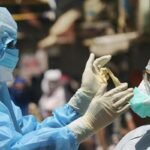In a study published in the journal Cell, researchers use a genetic database of more than 47,000 people in Estonia to identify a gene linked to thinness that may play a role in resisting weight gain in these metabolically healthy thin people.
The study implicated ALK as a key gene that may regulate thinness and play a role in resisting weight gain in metabolically healthy thin people.
Further studies in animal models showed that deleting ALK resulted in thinner flies and thinner mice, and demonstrated that ALK expression in the brain may be involved in regulating energy expenditure.
In a study published in the journal Cell, researchers use a genetic database of more than 47,000 people in Estonia to identify a gene linked to thinness that may play a role in resisting weight gain in these metabolically healthy thin people.
The study implicated ALK as a key gene that may regulate thinness and play a role in resisting weight gain in metabolically healthy thin people.
Further studies in animal models showed that deleting ALK resulted in thinner flies and thinner mice, and demonstrated that ALK expression in the brain may be involved in regulating energy expenditure.
In a study published in the journal Cell, researchers use a genetic database of more than 47,000 people in Estonia to identify a gene linked to thinness that may play a role in resisting weight gain in these metabolically healthy thin people.
The study implicated ALK as a key gene that may regulate thinness and play a role in resisting weight gain in metabolically healthy thin people.
Further studies in animal models showed that deleting ALK resulted in thinner flies and thinner mice, and demonstrated that ALK expression in the brain may be involved in regulating energy expenditure.
The Estonian Biobank that the team studied was ideal because of its wide age range and its strong phenotype data. But one limitation for replicating these findings is that biobanks that collect biological or medical data and tissue samples don’t have a universal standard in data collection, which makes comparability a challenge.
The team suggests its work is unique in its combination of population—and genome-wide-scale analyses into the genetic basis of thinness, with in vivo analyses of gene function in mice and flies. “It’s great to bring together different groups, from nutrition to biobanking, to hardcore mouse and fly genetics,” stated Penninger.
“Together, this is one story including evolutionary trees in metabolism, the evolutionary role of ALK, human evidence, and hardcore biochemistry and genetics to provide causal evidence.”






